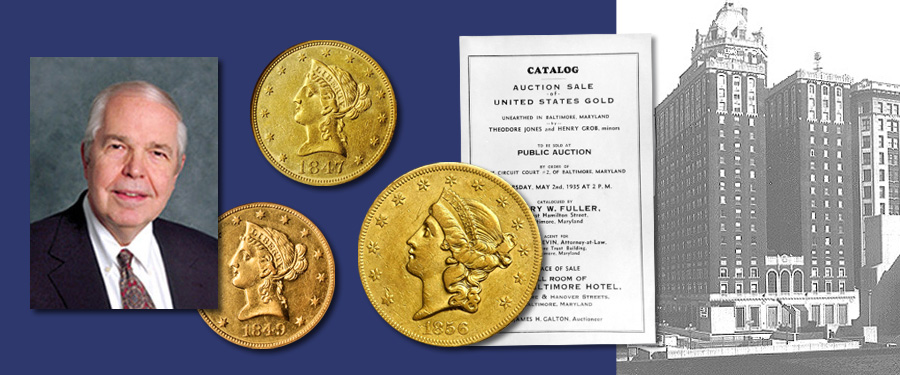
On August 31, 1934, two young boys were playing in the cellar of a house at 132 South Eden Street, East Baltimore, owned by Elizabeth H. French and Mary Findley and rented by the father of one of the boys.
Henry Grob, age 15, and his companion, Theodore Jones, 16, came upon a cache of gold coins. After a brief discussion as to what should be done, the lads took the treasure to the local police station and turned the find over to the authorities. Later, the boys said that they had "held out" some of the pieces, and these were subsequently added to the first group. One newspaper account put the amount as 3,558 coins with $11,425.50 face value. All were dated before 1857. Meanwhile, at the police station some of the patrolmen "tried their hand at cleaning them with coal oil [kerosene] and vinegar," a procedure definitely not recommended by numismatists!
How had the coins been hidden and by whom? One story had it that they were secreted by a sea captain of a ship in the coffee trade between Brazil and the port of Baltimore, who lived in the house with his two sisters. Another story printed in the October 1935 issue of The Numismatist suggested that "the coins may have been buried in April 1861 by a resident who was frightened by the passing of federal [sic] troops through the city; the house is located close to the depot at which the troops landed in Baltimore."
Multiple claims were filed for ownership. For the rest of 1934 and into May 1935 the matter was in the courts. Meanwhile, although the gold coins were to have remained undisturbed pending the outcomes, the family of one of the finders sold $185 worth for face value. Judge Eugene O’Dunne of the Second Circuit Court of Baltimore eventually awarded proceeds from the entire find to the two teenagers, negating an offer by the two ladies of the house to give the boys 24%. To finally settle the matter, the court mandated that the coins be sold at auction. The sale was held on May 2, 1935, at the Lord Baltimore Hotel downtown, with Perry W. Fuller serving as auctioneer. About 100 attended including a few out-of-town dealers and many local curiosity seekers. Grouped into 438 lots and casually described (most pieces were simply called "very fine") in a printed catalog, the hoard realized $19,558.75.
The star of the sale was a "very fine" 1856-O double eagle at $105 which went to a Virginia numismatist. An 1849-O $10, also "very fine," commanded $45. An 1841 $5, "fine, scratch on date," found a buyer at $26, and an 1847-O of the same denomination graded "fine," fetched $22. In an era in which there was very little numismatic interest in gold coins of higher denominations, most pieces sold for double face value.





